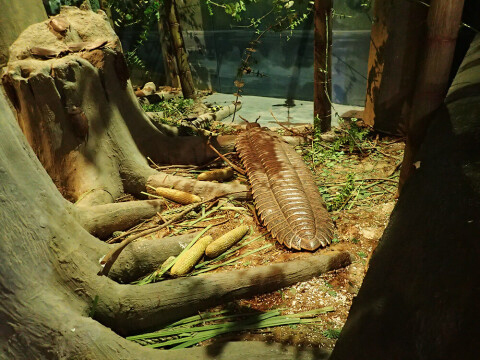Astonishing Monsters from the Carboniferous
Amazing Insights into Carboniferous Creepy-Crawlies
The Mesozoic may have the dinosaurs but this era was preceded by the Palaeozoic, the era of ancient life when strange and bizarre invertebrates ruled. One of the most significant periods in terms of the advancement of plant and animal life was the Carboniferous a time when the vast coal measures now used to support much of human activity on the planet were formed. The Carboniferous saw the advance of the tetrapods and their greater adaptation to a life on land. Vast forests of ferns dominated the landscape, but the vertebrates did not have these huge tracts of forest to themselves, this was the time of large insects and a new technique being used by a team of British scientists is provided new insights into the lifestyle of some of these amazing invertebrates.
A Typical Carboniferous Swamp Scene

It had been suggested that Arthropleura inhabited swampy environments. Whilst it was probably limited to equatorial regions, this study suggests it preferred open woodland.
Picture credit: Everything Dinosaur
A new 3-D analysis of delicate fossil arthropods and insects has provided new clues as to the habits and lifestyles of some of the first creatures to adapt to a sedentary life.
Fighting for survival in the leaf litter of the primeval forests were two arthropods, ancient creatures that are distantly related to modern spiders. Scientists used 3,000 individual x-rays of these two fossilised animals and then a computer model created remarkable 3-D images that provide much more data than an examination of the original fossil.
The animals were two coin-sized creatures called Cryptomartus hindi and Eophyrneus prestvicii.
Carboniferous
C. hindi and E. prestvicii were two animals that lived in the undergrowth, this new study provides astonishing details of their anatomy and scientists begin how these two particular creatures survived in the flourishing ecosystems of the Carboniferous. The new 3-D computer generated models have revealed new aspects of these ancient creature’s anatomies that has enabled the researchers to draw conclusions about how these animals lived. For example, the fossil evidence had indicated that E. prestvicii had long legs, probably an adaptation to running through the leaf litter after prey. However, these digitally dissected spiders have shown more detail, E. prestvicii had rows of spines on its back, possibly an evolved defence against carnivorous amphibians that also roamed around the forest floor.
The study, recently published in the scientific journal Biology Letters also concludes that the front legs of C. hindi were angled forward, presumably so it could grasp prey. The angle of the leg suggests that this particular ancient arachnid hid in logs or under leaf fronds, waiting to ambush smaller creatures as they came by. This adaptation is similar to the leg positions of a modern crab spider that ambushes prey in this manner.
New Discoveries
Commenting on the new discoveries, the lead author of this study, Russell Garwood, a PhD student at Imperial College, London stated:
“Our models almost bring these ancient creatures back to life and it’s really exciting to be able to look at them in such detail. Our study helps build a picture of what was happening during this period early in the history of life on land. We think one creature could have responded to increasing predation from the amphibians by growing spikes, while the other responded by becoming an ambush predator, hiding away and only exposing itself when it had to come out to eat”.
Garwood and his colleagues are hoping that this new imaging technique will be used to help bring back to life from the Carboniferous more amazing creepy-crawlies.
Everything Dinosaur stocks a range of models of Palaeozoic creatures including many invertebrates. For example, take a look at these models here: CollectA Prehistoric Life Models.

